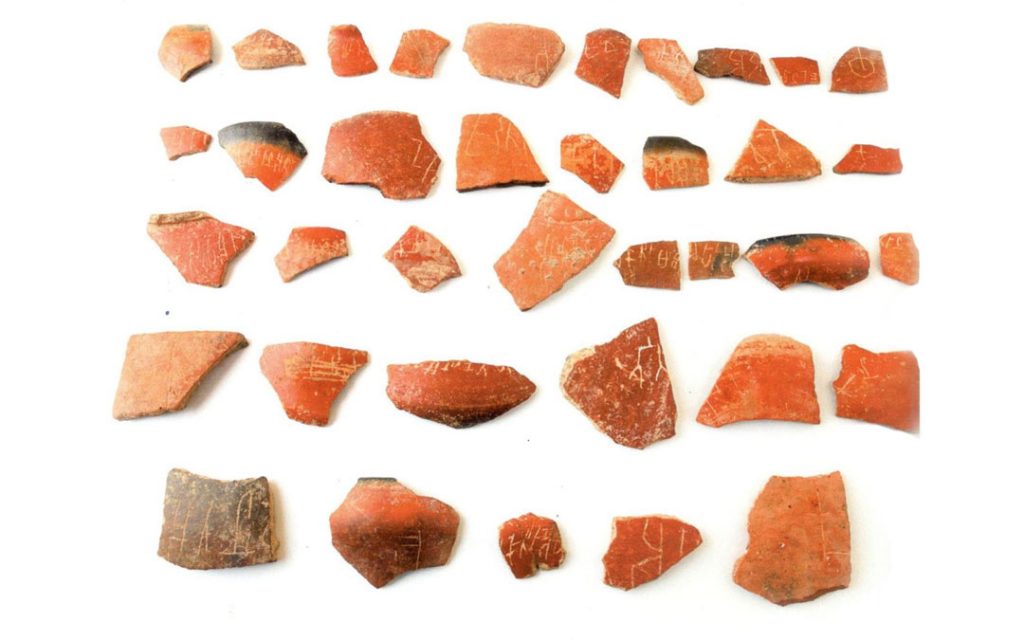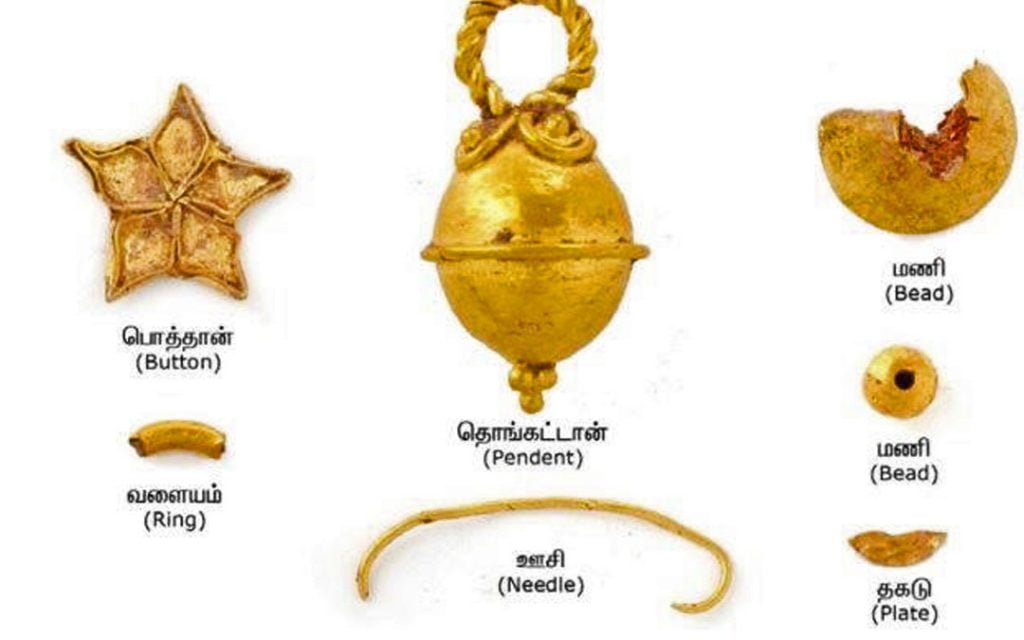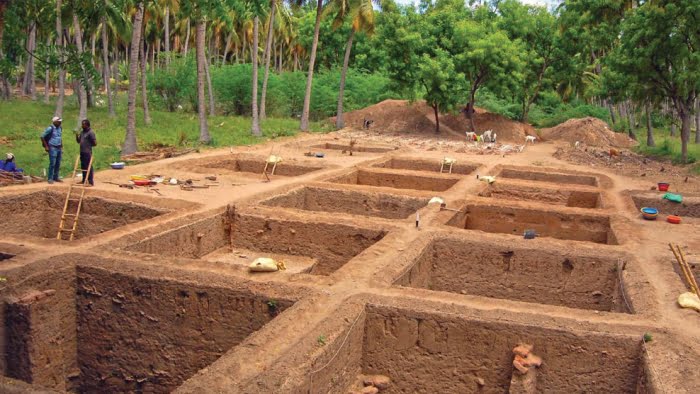From 2015, archaeologists have been busy digging out the treasures buried in Keeladi (also spelt as Keezhadi), a village in Sivaganga district, 12 km southeast of Madurai in Tamil Nadu. Amidst lush coconut farm, important parts of Indian civilisation is being unearthed by the Archaeological Survey of India (ASI) and the Tamil Nadu Archaeology Department (TNAD). The five phases of excavation have established that the antiquities unearthed here could date from the 5th century BCE to the 3rd century CE.
Location
About 12 kilometres east of Madurai, on the spanking new Rameswaram highway, the first excavation site was in Pallisanthai Thidal which is in the north of Manalur, about a kilometre east of the town of Keeladi. In less than two and a half meters below the ground level, the pieces of evidence found support that Keeladi is an urban settlement of Sangam Age on the banks of the river Vaigai. The ancient towns of Kondagai and Manalur are also said to be associated with this region.
Findings
The first three rounds of the excavation threw up strong clues about the existence of a Tamil civilisation that had trade links with other regions in the country and abroad. They provided significant archaeological evidence to the descriptions of Tamil poets belonging to the Sangam period (Tamil Sangam, an assembly of poets, had its seat in Madurai between 4th century BCE and 2nd century BCE. The works of this period are collectively called Sangam Literature). Recent findings have pushed the date of Tamil-Brahmi to another century—6th century BCE ascertaining that the Sangam era could have commenced much earlier to its previous assumption, 300 BCE.
The findings of the fourth and the fifth phases released by the TNAD reported that the artefacts found could be dated as far back as 580 BCE, or 2600 years ago. The artefacts included brick structures, potsherds, terracotta ring wells, fallen roofing with tiles, golden ornaments, broken parts of copper objects, iron implements, terracotta chess pieces, ear ornaments, spindle whorls, figurines, black and red pottery ware, and a few pieces of Arretine ware, besides beads made of glass, terracotta and semi-precious stones.

The hundreds of potsherds found were the first outward sign that gave a clue that something serious existed beneath the surface. Some potsherds were red on the outside and black on the inside indicating black-and-red ware pottery and that the potters of Keeladi were familiar with the technique (of using carbon material for black colour and hematite for red) and knew the art of raising the kiln temperature to 1100°C. More significant are the letters engraved on pots that demonstrate the high literacy level of the contemporary society that survived in 6th century BCE. Some of the symbols found in potsherds of Keeladi bear a close resemblance to Indus Valley signs.
The findings of gold jewellery, hundreds of finely crafted beads made of terracotta, glass and carnelian, and game pieces establish that the ancient Keeladians were generating enough surplus, to afford to the extras: precious adornment, industry and leisure/fun. An advanced civilisation that celebrated life. The absence of coins suggests the residents depended on the barter system. Interestingly, Keeladi has not revealed any signs of religious worship in all five rounds.

Among the findings is an orange carnelian bead engraved with the image of a wild boar. Carnelian stones, from the quartz family, are not found in Tamil Nadu, but in the north-western parts of India. The engraved bead could date back 2,000 years. It hinted at the possibility of an ancient north-south trade link.
Source: The Hindu
Water-management infrastructure predominated in the finds. Three kinds of channels have been discovered so far for suggesting different qualities of water being transported—fresh water, sewage, industrial waste. the report, ‘Keeladi-An Urban Settlement of Sangam Age on the Banks of River Vaigai’, which says. “Excavation of 10 spindle whorls, 20 sharply pin-pointed bone tip tools used for design creations, hanging stones of the yarn, terracotta spheres, copper needle and earthen vessels to hold liquid clearly attest the various stages of weaving industry from spinning, yarning, looming and weaving, later for dyeing.“
One hypothesis for the Keeladians to move water strategically from place to place for some functions are industries and this heavy usage of water at such depths explains that river Vaigai has run far closer to Keeladi 2,500 years ago. Like many riverside settlements which decline when the water source runs out, Keeladi too would have declined when their river might have shifted its course. Today, the Vaigai runs well over a kilometre away from the ancient Keeladi settlement.
The first three rounds of excavation were undertaken by the ASI. After the second phase of excavations, K Amarnath Ramakrishna, the Superintending Archaeologist along with 26 officers were transferred all over India. This caused unrest in Tamil Nadu and its people questioning BJP’s motive behind this.
Bridging gaps with Indus Valley Civiisation
The Indus Valley Civilisation (IVC) declined 1,300 years before the thus-far dated Keeladi site. Could the descendants of IVC inhabitants be involved in this site? During the fourth round, 72 potsherds with Tamil-Brahmi script were discovered at the site. Some of these artifacts have inscribed graffiti marks, similar to graffiti marks which some believe to have evolved from the Indus script. This may point to a link between the scripts of the Indus Valley Civilization and Tamil-Brahmi. K. N. Dikshit in 1939 when he was Director General of ASI:
“Considering that the conch shell, typical of the Indus Valley civilisation, and which seems to have been in extensive use in Indus cities, was obtained from [the] south-east coast of the Madras Presidency, it would not be too much to hope that a thorough investigation of the area in Tinnevelly District and the neighbouring regions such as the ancient seaport of Korkai will one day lead to the discovery of some site which would be contemporary with or even little later than the Indus civilisation.“
Also read: Janki Devi: The Woman Who Took Part In Swadeshi Movement | #IndianWomenInHistory
Controversy
The first three rounds of excavation were undertaken by the ASI. After the second phase of excavations, K Amarnath Ramakrishna, the Superintending Archaeologist along with 26 officers were transferred all over India. This caused unrest in Tamil Nadu and its people questioning BJP’s motive behind this. In addition to withholding funds, when the third round was believed to be deliberately delayed the Madurai Bench of the Madras High Court intervened and permitted the TNAD to take up further excavation.
The potsherds found in Keeladi have predominant Tamil-Brahmi inscribed. These marks are found to be engraved after the pot is dried, indicating that these marks were not made by the potter but by the user, mostly women who must have had a high literacy level.
“The materials found in Keezhadi provide undeniable evidence of secular culture in South India. This is in odds with the BJP government’s Hindutva agenda and they will take every measure to ensure further research is not done in these sites,” alleges V Arasu, former HOD of Tamil Literature at the University of Madras.
Early Signs of Feminism
Of the three habitation sites excavated in Tamil Nadu so far, Keeladi has far greater importance and traction than the other two—Arikamedu, in 1947, and Kaveripoompattinam, in 1965. The potsherds found in Keeladi have predominant Tamil-Brahmi inscribed. These marks are found to be engraved after the pot is dried, indicating that these marks were not made by the potter but by the user, mostly women who must have had a high literacy level.
Amidst all the findings, archaeologists have found no sign of worship/religion/god indicating Keelaid being a secular society. There’s also been no sign of coins, symbolising an interdisciplinary civilisation engaging solely by barter system signifying the high level of acceptance, tolerance and equality towards their fellow Keeladians.
Also read: What Do We Know Today About The Keezhvenmani Massacre?
With lots of questions still pending about the Keeladi settlement’s developmental chronology, The State government has already approached ASI to declare five villages—Keeladi, Agaram, Manalur, Konthagai (a burial site) and Pasiapuram—as the Keeladi cluster. The State has also decided to continue excavation in other sites and prove the link among places such as Adichanallur and Alagankulam.
References
Feature Image Source: Vikatan
About the author(s)
Nivedita Jayakumar is a Computer Science engineer who is now doing her Master's in Communication and Media.





Out of 240 poets there are more than 40 women contributed Tamil sangam literature, some of female poet belong to pottery maker, fishing community. Even entire layer of Sanskrit or any ancient classical literature doesn’t have such huge number of women poet. According to Megasthenes in indica, madurai was ruled by queen. Even most Indus seal script mostly has fish sign, meen+achi(fish+rule). Predominantly ruler of vaigai river consider as pandiyas, ruler of madurai as meenachi.
The fact that coconuts are an integral part of North Indian rituals, even though they grow only in the coastal regions down south, is proof enough that migration happened northwards.
How can term it as Indian civilization. You have to term it as Tamil civilization. During Sangam period country India was never there… Many princely countries were there… So please rewrite it as Tamil civilization
I would certainly agree with your perspective. Ganesamoorthy
ok, those symbols seem very self explanatory, 225 some kind of fish, 307 Bow and arrow, first-318 closed door, second-318 rice(or some kind of grass).
https://mk0vinavuu9wl1kmwant.kinstacdn.com/wp-content/uploads/2019/09/Keeladi-Book-English-18-09-2019.pdf
It’s the link of the “KEELADI EXCAVATION ” Officially released by DEPARTMENT OF ARCHAEOLOGY
GOVERNMENT OF TAMIL NADU